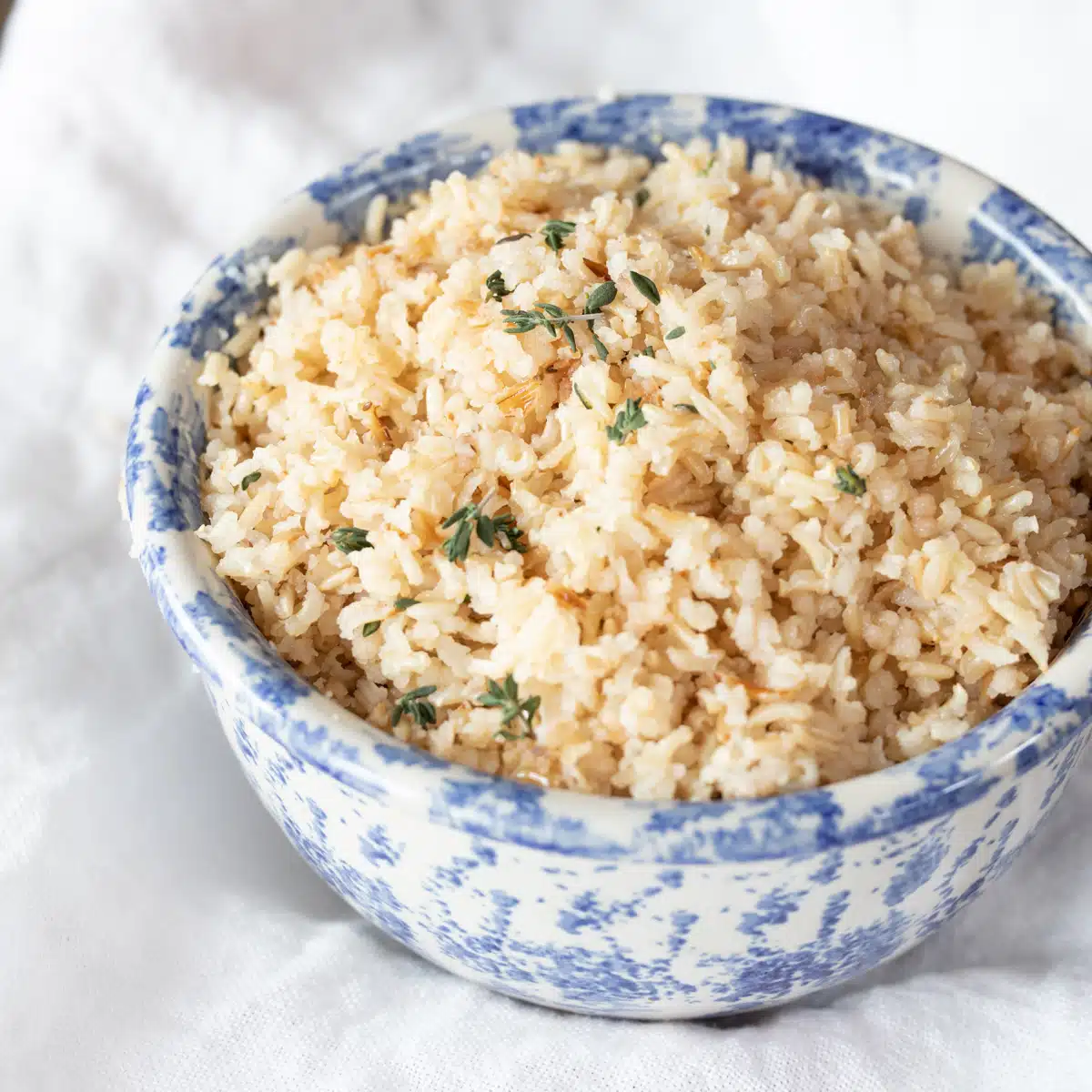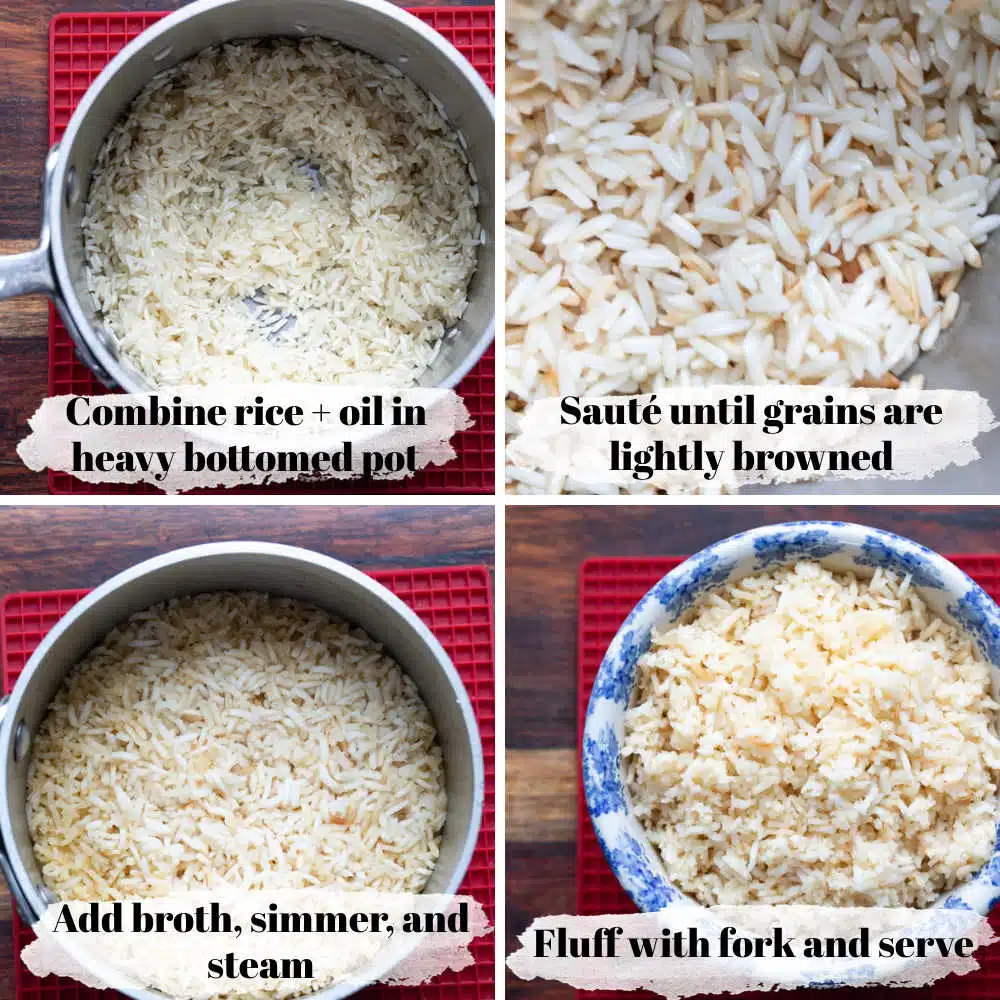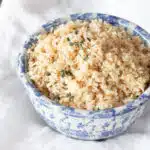If you want to make perfect rice every time without a rice cooker, this post is for you. It covers which type of rice is best for fluffy rice, the best water to rice ratio, how long to cook it, and 6 tips for making perfect fluffy rice every time.
Jump to Recipe
Want to make fluffy rice perfectly the first time? I want to help with that. So, check out this Table of Contents to see which sections of this post will help you the most.
Jump to:
- 🤷♀️ What are the types of rice?
- 🍚 Types of Rice That Cook Up Fluffy
- 🍚 What's the difference between Basmati and Jasmine Rice?
- 👩🍳 Do I Need to Rinse Rice Before Cooking?
- 👩🍳 How Much Water Should I Use to Cook Rice?
- 👩🍳 How Long Should I Cook Rice?
- 📝 Instructions Overview
- 🎯 Six Tips For Perfect Fluffy Rice
- 😋 Ways to Make Rice Flavorful
- Perfect Fluffy Rice with Tips (White AND Brown Rice)
I make a lot of rice. It's a perfect side dish for me with veggies of course, and I add it to this broccoli cranberry salad and vegetable rice soup. But it's also a fabulous canvas for infusing flavors. For example, I toss it with green mint chutney and top it with tomatoes and nectarines in the summer. But I also love to make biryani, mujadara, and this herbed rice salad.
🤷♀️ What are the types of rice?
Not all types of rice cook up fluffy. So it's important to start with the types of rice, and which types can be fluffy. Just like when selecting between the various types of lentils, each has its own flavor, texture, recommended uses, and cooking instructions. It can be confusing!
Rice that cooks up fluffy, are all classified as long-grain rice. Shorter grain types of rice such as arborio, a medium-grain rice, and sushi rice, a short-grain rice, will never cook up fluffy due to their physical composition.
Sticky rice, also known as glutinous rice or sweet rice, is an exception. It's a long-grain rice, but as it's name suggests, it's sticky. That's because of its unique starch content that makes it super sticky when steamed.
Black rice, also called Forbidden rice because it was reserved for the emperor and his family in earlier times, comes in long-, medium-, and short-grain forms, but is most often seen in medium. It tends to be sticky when steamed regardless of its length.
Wild rice is a wild variety of semi-aquatic grass which is native to America and Canada, and genetically differs from rice varieties.
Below are the types of rice that, when prepared correctly, cook up fluffy.
🍚 Types of Rice That Cook Up Fluffy
Standard Long-Grain Rice (White and Brown)
- If the bag of rice is unlabeled for the type of rice, this is 99% of the time standard long-grain rice.
- Both the flavor and aroma are very bland IMO.
Basmati (White and Brown)
- Basmati is a type of long-grain rice grown in North India, in the foothills of the Himalayas.
- It has a fragrant aroma and slightly nutty flavor when cooked, and should be a light golden color when purchased.
Jasmine (White and Brown)
- Jasmine is a type of long-grain rice grown in Southeast Asia.
- It has a floral plant-like aroma and subtle nutty flavor. Some say the flavor is more plant-like than other long-grain rices.

🍚 What's the difference between Basmati and Jasmine Rice?
They both produce a fluffy cooked rice, but Basmati rice has the edge.
Jasmine rice is grown in a humid climate, and holds a little more moisture. This means it cooks up a little softer, and just a tiny bit stickier. Basmati rice cooks up drier, and therefore fluffier.
If you want your best fluffy rice, use Basmati rice.
👩🍳 Do I Need to Rinse Rice Before Cooking?
Yes and no. It's less important to rinse long-grain rice before cooking than for medium- or short-grain types of rice, as it removes some of the extra starch in the grain. But I believe rinsing rice before cooking it is a good general practice to follow.
I place the rice in a fine mesh strainer, and rinse under a stream of cold water while I feather through the rice with my fingers. It only needs a minute. At the most.
👩🍳 How Much Water Should I Use to Cook Rice?
That depends on whether the rice is long-, medium-, or short-grain, and if you're cooking white rice or brown. Bottom line, follow the directions on the bag. But a good rule of thumb with long-grain white rice is 1 ½ as much water as rice, and 2 ½ times more water when cooking brown rice.
Water to Rice Ratio (white rice): 1 ½ cups of water per 1 cup of rice. Water to Rice Ratio (brown rice): 2 ½ cups of water per 1 cup of rice.
But many recipes on the internet state that the water to rice ratio is 2 to 1. Why is that? There are a few reasons, IMO:
- The amount of water needed can vary according to the age of the dried rice. The older the rice is, the drier it is, and more water it needs.
- Not having enough water means the rice sticks to the bottom of the pot, and may scorch. And whoever washes the pots and pans in your house will not be happy.
- This rice to water ratio is easy to remember 😁.
But using too much water means you must drain the cooked rice using a fine mesh strainer before quickly returning it to the pot to steam. It also risks soggy rice. Particularly if you don't drain the excess water off as soon as the rice is cooked.
👩🍳 How Long Should I Cook Rice?
Just as with the rice to water ratio, the cooking time depends on whether the rice is long-, medium-, or short-grain, and if you're cooking white rice or brown.
It also depends on whether you lightly toast the rice first in a little olive oil or butter (see the below Six Tips for Perfect Fluffy Rice). Toasting the rice shortens the cook time by 5 minutes for white rice, and by 10 minutes for brown rice.
Bottom line, follow the directions on the package, but here's a good guideline if you choose not to toast the rice first:
Cook time for white long-grain rice: 15 minutes. Cook time for brown long-grain rice: 50 minutes.
📝 Instructions Overview

🎯 Six Tips For Perfect Fluffy Rice
Cooking rice should be easy, and yet we often end up with sticky rice when we want it fluffy. Here are 6 tips for ensuring you always end up with tender rice that's fluffy.
- Use a heavy bottomed pot to prevent burning or scorching. It's harder to control a heated surface that is thin.
- This is important to the finished texture of the rice.
- Sauté the rice in a little olive oil until lightly toasted before adding the water.
- This not only kicks up the flavor of the rice, it also coats the grains, allowing them to slide against each other without developing starchiness. So, even if you don't sauté the rice first, still add that little bit of oil.
- As a side benefit, this sauté step also shortens the cook time (see the above section on cooking time for rice).
- Use the correct water to rice ratio (see the above section on how much water to use for white rice versus brown rice).
- Too little liquid can result in partially cooked rice stuck to the bottom of the pot, a seemingly permanent condition.
- Too much liquid can give you soggy rice.
- Cover the pot while the rice is simmering and be sure to keep it at a low simmer.
- Don't be tempted to stir the rice while it cooks. Ever.
- When the rice is done, remove from the pot from the heat and keep it covered for 10 minutes before tossing it with a fork.
- This gives the rice time to evenly distribute its moisture. Otherwise the rice on top will be dry, and rice on the bottom will be wet.
As a note, you can also rinse the rice under cold water to remove excess starch. But, while rinsing the grain is a good practice, this is less important to getting a fluffy rice when cooking long-grain rice.
However, if you want to reduce the starch in medium-grain rice such as arborio, or short-grain rice, soak the uncooked rice grains for 30 minutes, followed by a thorough rinse.
😋 Ways to Make Rice Flavorful
- Toast uncooked rice grains in a little olive oil or butter for 5 - 10 minutes before adding water.
- Use homemade vegetable stock or Better Than Bouillon - Roasted Vegetable Paste in place of water.
- Add salt to the water when it's added to the rice. This ensures an even flavoring throughout the rice. This is the time to add other spices, such as cardamom or cinnamon.
- Make chipotle seasoned rice by adding dried chipotle powder and a few other spices.
- Add fresh herbs to the rice while it steams at the end. Fresh thyme leaves are a particularly wonderful addition at this time for both white and brown rice.
- Stir in some herb compound butter.
Perfect Fluffy Rice with Tips (White AND Brown Rice)
Ingredients
- 2 teaspoons extra-virgin olive oil
- 1 cup basmati long grain white rice
- 1 ½ cups water or water
- 1 teaspoon Better Than Bouillon, Roasted Vegetable Paste
- ½ teaspoon kosher salt (¼ teaspoon sea salt)
- 2 teaspoons fresh thyme leaves
Instructions
- Rinse the rice under cold water, and strain using a fine mesh strainer. Dry with a towel if you plan to sauté it in olive oil before adding the cooking water.
- Warm the olive oil in a heavy bottomed pot over medium-high heat. Combine rice with the oil and toss with a wooden spoon to evenly coat the grains. Toast the grains for 5 - 10 minutes until fragrant, and some grains begin to turn a light brown.
- Heat the water in the microwave oven almost to a boil, and stir it into the rice, along with the Bouillon and salt. This is a good time to add any other spices you want for flavoring the rice.
- Lower the heat, and bring to a low simmer, stir one final time, cover with a lid. and reduce the heat to maintain a low simmer. Simmer for 10 - 12 minutes without stirring.Carefully pull out a few grains on the top and check if they're done to your satisfaction. If not, cook a little longer.
- When the rice is done, stick a spoon straight down into the rice all the way to the bottom of the pan. Gently nudge a little rice away just enough to see if there's any broth still at the bottom of the pan.
- If the bottom of the pot is dry, remove the pot from the heat, add the fresh thyme, and lightly mix into the top layer of cooked rice. Cover the pot for 10 minutes, and fluff the rice with a fork. Add additional thyme if desired.
- (If some broth remains in the pot once the rice is cooked, strain it out by dumping the cooked rice into a fine mesh strainer, and quickly dump the rice back into the pot, and continue with the above step.)


Norma Chang
Great rice cooking tips. Tip #5, don't stir is very important.
The Chinese dim sum dish Lotus Leaf Wraps (Lo Mai Gai) is made with white glutinous rice also known as sticky rice so no matter how you cook it, it will be sticky.
The Wimpy Vegetarian
Good to know Norma! Thanks, I'm definitely not an expert on Lo Mai Gai. Thanks for the information 🙂
Choc Chip Uru
I eat too much rice as it, this looks so delicious 😀
Yet another excuse to stock up on rice!
Cheers
Choc Chip Uru
The Wimpy Vegetarian
I love rice! And I probably eat more of it than I should too 🙂
Rita
Great info Susan! My hubby (an engineer) is the rice maker in our kitchen. We've pretty much switched to brown rice (Tsuru Mai brand) even for a Chinese stir-fry side. He's got the cooking method "down"! Love the chewy texture.
The Wimpy Vegetarian
Me too, I really like that chewy texture. I've been doing a lot more brown rice, but I've been working on a mango-pineapple rice dish and it just doesn't photograph as well with brown rice. Ah, the sacrifices we make for art LOL.
ChefJohn
Susan, Here's a couple of notes about cooking rice that I was given back in the 50s. I guess things have changed a lot since then, but for fluffy rice, this still works for me.
I start with about 4 times as much water as the amount of rice I'm going to cook, and bring it to the boil. I then add about 1/2 Tablespoon of butter (you could use oil) and salt, The rice is then poured gently into the water, slowly enough to keep a "rolling boil". Cook the rice at a very high simmer, so that the water motion keeps the grains circulating in the pot.
Taste a few grains every 30 seconds after about 8 minutes, until it’s done to your liking/requirements. When cooked, drain immediately under Cold running water, then, while still in the strainer, run hot water over it to heat it again. Repeat this 2 more times, then place in a warmed bowl. Fluff with a fork before serving.
I know this has little to do with the ‘absorption method’ you mention above, but it has always worked for me.
My English Grandfather, who was a French-trained Chef/Pastrycook called it “Rice of the seven waters”, never used the absorption method, saying that there was too much variation in rice grain size, starch content and change due to storage time before sale for the absorption method to be dependable.
As I said before, a lot has changed in the last hundred years or so, but this method has always worked for me.
The Wimpy Vegetarian
This is fascinating! I've not seen this method but I really want to try it. Between the large amount of water giving the grains plenty of room, the butter/oil that's coating the grains a little, that's preventing excess starch, I'm thinking. And the 4 rinses (2 with cold water, 2 with hot water) is removing a lot of what does build up. All this supports a fluffy outcome. What interests me is that this is a good solution for the variation we naturally get in our rice. I'm going to try this method next! Thanks so much for sharing.
mjskit
I'm with you - I don't need another appliance! 🙂 I'm pretty inconsistent with my rice so this post has been very helpful. I will be trying some of your tips. Thanks!!!
The Wimpy Vegetarian
I hope they work for you too, MJ! And hope you're enjoying your summer 🙂
cheri
Great tips Susan, as always great post!
Oui, Chef
Great tips, Susan, I'll use them all the next time I make a batch of rice.
Ali
I LOVE these tips. My means didn't too often consist of rice growing up, and when they did, it was usually minute rice or boxed Rice-a-roni. So when I got married, I added a rice cooker to our gift registry. I don't know if it's me or the rice cooker, but it almost always ends up pretty mushy... Needless to say, I will be using these 6 tips next time I make rice! Thank you!
Ali
Oh goodness. I didn't proofread. Means=meals. 😉
Rachel
If you are using a rice cooker then use the same amount of water as you are using rice and add some olive oil and salt. it shouldn't come out mushy
Ali
My rice cooker's instructions said to use a 2:1 ratio of water to rice. Or maybe I read it on a bag of rice... Well, I don't remember where it was, but I know I read to use a 2:1 ratio, and I eventually realized that was wrong. I've stopped doing that though, and my rice is much better! 🙂
michelfrost
Amazing Tips! I had tried this tips to make perfect rice & its result was awesome. I found perfect fluffy rice. Thank you for sharing it & keep sharing such type of tips with us..
Margaret @findbestreview
I’ve never been able to cook rice well I always ruin it. But after doing it the way you said it turned out amazingly!! Thank you for sharing
The Wimpy Vegetarian
I'm so happy it worked so well for you!!!! Thanks so much for letting me know. I know I'm responding way late of you posting this, but for some reason, just now seeing it!